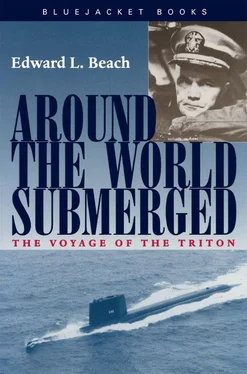I am well aware of all of these historical matters as I look over the side and ponder the advisability of letting George and his people go down on deck. Seas are sweeping freely across our deck aft, but that is of no particular importance at the moment. Our bow is staying about a foot out of water, but around the conning tower, where I am looking over the side, the deck is frequently inundated. The night is cold and dark, completely overcast, and a light drizzle is falling. The sea feels warm.
With a little luck, George and his men will very likely have no difficulty under conditions as they are. But the risk looks a little too great. With a low freeboard the transfer is aided, provided it isn’t so low that there is risk to your deck crew. Besides, even though Poole is at the moment having a remission, partly with the help of morphine, transferring him under any but the best conditions for his health and safety is out of the question.
Again, there is really no decision to be made at all. Technicalities about staying submerged have got to give way to the realities of the situation; the safety of the people involved in this operation is more important than anything else. We will have to come up a little higher. I push the button energizing the microphone to the control room.
“Control, Bridge, blow forward group for one second.”
“Forward group, one second, aye aye,” from control. Almost simultaneously, I hear air whistling into the tanks forward. It blows for a second, stops abruptly.
The effect is most apparent. The ship having previously been carefully brought to perfect trim, addition of a thousand pounds or so of buoyancy in the forward section lifts her until the displacement [not weight] of Triton’s above-water volume equals that of the water displaced by the air in the tank. The superstructure, being entirely free to flood, displaces very little water, except for the conning tower itself, and the forward section rises several inches. The main deck in the area of conning tower and sail is now fairly clear, only an occasional wave slapping over it.
Sawyer’s voice from below, “Permission to open the access door and go out on deck, Captain?”
“Open the door, but do not go out on deck until I give you permission.”
This is just to keep control to the last before letting him go. I can hear the sound of the fastenings being opened up and the door swinging wide.
George again: “Looks all clear topside, Captain, permission to go out on deck?”
“Affirmative!” I yell back.
In the distance, the lights of the approaching motorboat are visible coming around our stern. Down below, in the flickering semilight cast by their flashlights, the men of the deck force reach through the open access door, affix their travelers to the track, and then, holding their safety chains taut, step swiftly forward on the main deck. Two men quickly turn to on a collapsible cleat just forward of the sail and rotate it upward. This is the point where we plan to take the boat’s bowline. Two other men, carrying paint pots, move aft along the sail and hurriedly commence daubing at our starboard side block numbers.
Possibly some unknown vagary in water density or wave action has commenced to affect us as Macon’s boat approaches. Two or three seas roll over the foredeck. George has his men by this time arranged alongside the sail, gripping the handhold bars, and of course holding on to their safety belts. Gazing intently over the side of the bridge in the misty darkness, I am unable to see any evidence of paint pots, a fact which does not surprise me, is on the contrary something of a relief. As I watch them anxiously, a larger than average sea mounts up the side, and all of them are momentarily buried up to the neck. George shouts “hang on” as the water rises about them. All were already pretty well soaked and the danger is more apparent than real, but we can’t let this continue, “Blow the forward group for one second,” I again order the control room, and again there is the welcome blast of high-pressure air into the tanks. This brings the deck up again and we motion the boat alongside.
In the meantime, Jim Stark and John Poole have been waiting in the conning tower. We have used the last few hours, during which he has been free from discomfort, to brief Poole thoroughly on what he can say and not say, once departed from Triton. His transfer papers and other official documents are made up in waterproof bags and attached firmly to his person. He him self is so bundled up and swathed with protective clothing and life jackets that he can hardly get through the hatch. At the word from Stark that all is ready, I order the two men to the lower bridge. Our good-byes have already been said. There is no time for more than a last hasty “good luck” to Poole.
The boat is alongside, bow painter around the cleat and held by Wilmot Jones. Two men in the boat hold her off from our side with reversed boat hooks. Chief Fitzjarrald and Sawyer steady Poole and a couple of the men in the boat stand by to catch him. Seizing a moment when the gunwale of the boat is level with the edge of our deck, Poole steps easily and quickly into it. It is a standard Navy motor-whaleboat, evidently Macon ’s lifeboat, manned with a crew of about 5 people. It is a pleasure to watch the boat’s coxswain maneuver his frail craft alongside. There is no doubt that he knows his business. Poole hasn’t even gotten wet, and the boat’s gunwale has only once touched our side.
In a moment, the riding line is cast off. The men with boat hooks push hard, the engineer guns the engine, and they are away. Another moment suffices to get George and company back on the lower bridge.
“All clear on deck, Captain!” shouts Sawyer. “We didn’t get any painting done though. The first wave flooded the paint pots. Anyway, the paint wouldn’t stick, and the old paint is pretty well stripped off by the water anyhow.” This was a point we should have thought of, but all’s well that ends well. Then they are below, hatch shut behind them.
While waiting for further word from the Macon, Machinist’s Mate Bob Carter is busy with a hacksaw, taking off the loose bridge guardrail we had noticed. In a few minutes the welcome word comes from our Communications Officer, Lt. Bob Brodie, in Radio: “Bridge, Radio—from the Macon —Poole safely on board.”
Among the papers Poole has with him are personal letters of appreciation to Admiral Stephan and Captain Reuben Whitaker. More than our thanks for their help, there is little information we can give them about our trip. They must be bursting with curiosity. We send a final message of thanks and then, with topside clear and hatch shut, I order Dick Harris, Diving Officer of the Watch, to return to periscope depth. The air bubble in our tanks is released, and gently Triton eases her sail into the warm sea. The total time with the bridge above water has been less than an hour. With a deep feeling of gratitude for the way the Navy has come through, we shape our course at maximum speed southward.
Now that we have successfully solved the difficult problem about Poole, the atmosphere in our ship lightens considerably. With everything wide open, Triton is again heading for Cape Horn. This time we will save time by passing to the west of the Falkland Islands and head for Estrecho de le Maire, a small strait between Staten Island [familiar name] and the main part of Tierra del Fuego.
We calculate that we will have gone 2,000 miles out of our way on this mercy mission, and it has cost several days. The distance is almost equal to an Atlantic transit.
10

Читать дальше













